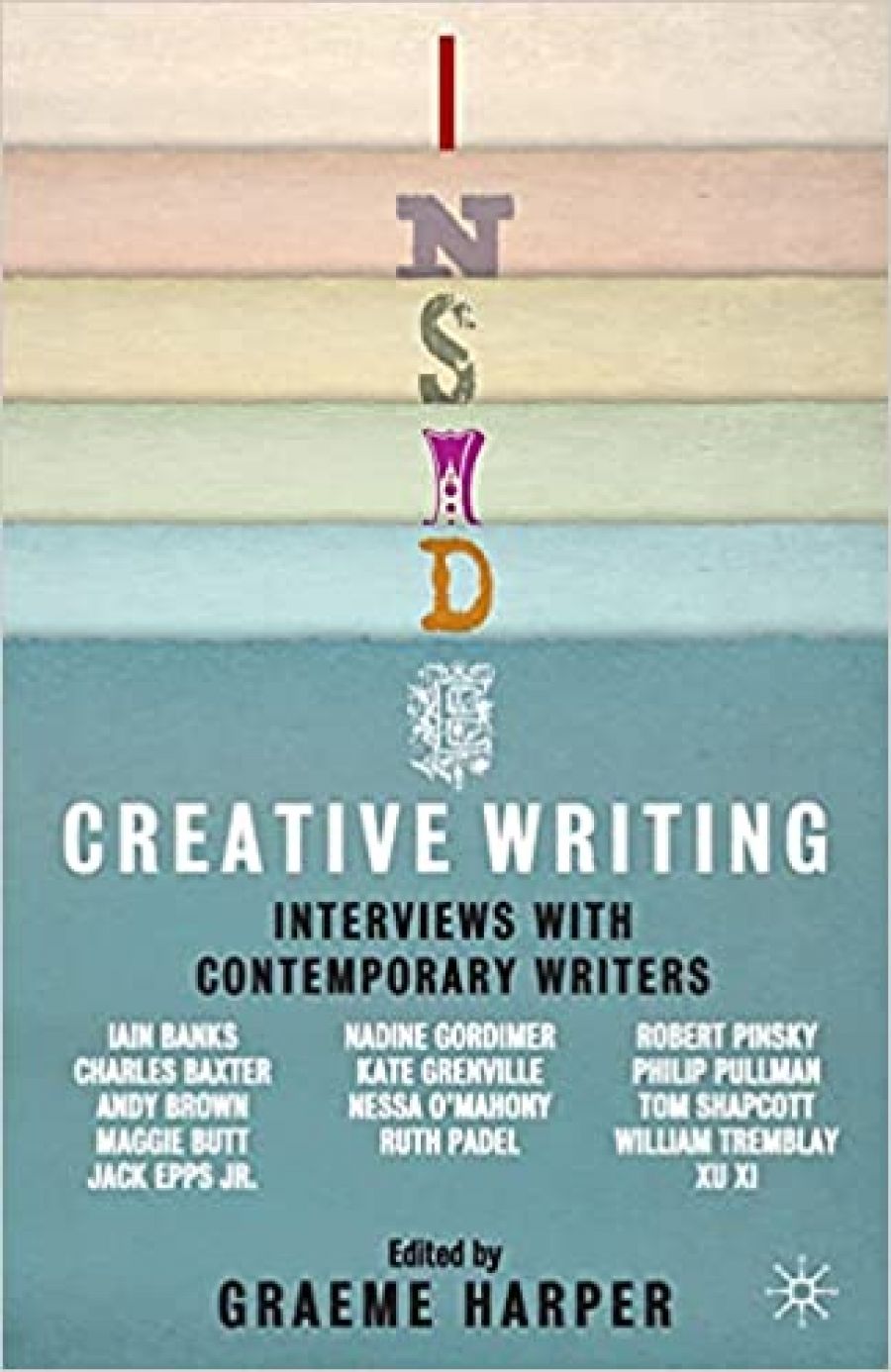
- Free Article: No
- Contents Category: Fiction
- Review Article: Yes
- Article Title: Narrative things
- Online Only: No
- Custom Highlight Text:
Graeme Harper is a big name in the academic field of creative writing. He was the first in Australia to be awarded a doctorate in creative writing (UTS, 1993) and followed that with a PhD from the University of East Anglia; he has held professorships in creative writing in the United Kingdom, Australia, and the United States. He edits journals and writes textbooks on creative writing; his curriculum vitae lists more than seventy-five keynote addresses given on the subject, and thirty-one grants and fellowships. As Brooke Biaz, he also writes fiction. How does he find the time? Any academic will confirm that nothing so effectively limits one’s own creative writing output as does teaching the subject.
- Book 1 Title: Inside Creative Writing
- Book 1 Subtitle: Interviews with contemporary writers
- Book 1 Biblio: Palgrave Macmillan, $29.95 pb, 224 pp
Inside Creative Writing is ‘edited by’ Graeme Harper, I assume because it includes contributions from other writers. But Harper’s input is at least as much as theirs, if not more. To begin with, there is a lengthy Introduction, in which he outlines the types of creative writing he is interrogating: not the completed works of a creator, but something undertaken ‘in the realm of the individual’; ‘a decidedly human event, an activity that is driven by our urge to create’. How might we improve our understanding and knowledge of this activity? His answer is to pose fifteen questions to fourteen writers: Iain Banks, Charles Baxter, Andy Brown, Maggie Butt, Jack Epps Jr, Nadine Gordimer, Kate Grenville, Nessa O’Mahony, Ruth Padel, Robert Pinsky, Philip Pullman, Tom Shapcott, William Tremblay, Xu Xi – six Brits, five Americans (Xu Xi, from Hong Kong, holds American citizenship), and two Australians. Eight hold postgraduate degrees and academic posts in creative writing.
The book’s fifteen chapters each address a different topic – writing craft and skill, drafting, habitats, subjects, themes, creative writing exercises, etc. – first with Harper’s specific question and his own comments, followed by the answers he received from his contributors. Readers who buy the book in the expectation of its being a collection of lengthy interviews with contemporary writers in the style of, say, the Paris Review or the illuminating Writers on Writing (2002), edited by James Roberts et al., may be disappointed. In the latter, twenty-four writers attending the 2000 Adelaide Writers’ Week were asked about their working methods, the questions covering much the same territory as Harper’s does. Apart from a brief Introduction from the editors, their words comprise the entire book. Inside Creative Writing contains a lot of Professor Harper, and his style may not be to everyone’s taste. He has, for instance, a liking for the exclamation mark, which begins in the Acknowledgments (‘Thank you, one and all!’). Ordinary observations, in his voice, sound profound: ‘Creative writers spend much of their time in moments, and in modes of perception, memory, and (sometimes wild!) speculation. Without such activities creative writing wouldn’t occur.’ Full credit to him, however, for not editing out some answers: Philip Pullman’s irritation fairly leaps off the page:
Q: Do you ever wonder what other creative writers do as they draft their works? ... [Do] you think, ‘I wonder if X finds this hard?’
Pullman: No. I know how I do it, and I don’t care how X does it.
To this question, Kate Grenville usefully points readers to her own book (with Sue Woolfe) Making Stories (2001), which covers similar ground to Harper’s by using concrete examples of work in progress and, together with The Writing Book (1998), is still widely used in creative writing classes. She could teach Harper a thing or two about concise expression. To a waffly and long-winded question concerning the sort of ‘knowledge creative writers use’ and ‘how valuable this knowledge might be’, Pullman replies: ‘There are narrative things I’ve discovered [...] and I suppose if I had nothing else to do I could write them down in a book and persuade someone to publish them, but it seems more fun to put them into practice.’
Ouch! Those ‘narrative things’ are exactly what Harper is pursuing and are of more than passing interest to readers, but Pullman, it becomes clear, is not big on theory. It must be said, too, that some of the questions are rather daft and some of the answers less than illuminating. Harper asks the writers if they can suggest a ‘brief activity’ somebody might undertake that ‘has the potential to reveal something about creative writing’. (Read a novel? Go for a walk?) ‘Sorry, no idea,’ replies Ruth Padel. Gordimer’s answer makes little sense; Tom Shapcott suggests letting ‘the computer of your subconscious play its part’ and to research settings; Pullman has ‘no useful tips. If someone wants to do it, they’ll do it. If not, not.’
The reality is, however, that fifty tertiary institutions in Australia and New Zealand now offer degrees in creative writing. Many of the tutors are recent postgraduates with little teaching experience and no publication history beyond a few academic papers. ‘When I don’t know what to do in my class,’ one such tutor confessed to me recently, ‘I set writing exercises.’ Inside Creative Writing is aimed squarely at this growing market.


Comments powered by CComment